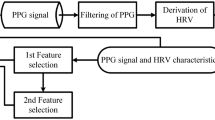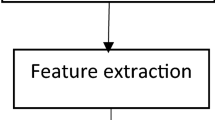Abstract
Sleep apnea is a potential sleep disorder, which deteriorates the quality of sleep. It is characterized by the obstruction in nasal airflow, which results in a low concentration of oxygen in the blood. Though polysomnography (PSG) is considered as a gold standard for diagnosing sleep apnea, it is arduous, demanding, expensive and inconvenient to the patients. This study presents an effective, efficient and sustainable sleep apnea automated detection system using pulse oximetry signals (SpO2), which indicate the percentage of oxygen content in the blood. The conventional methods, which employ PSG recordings are computationally intensive and costly. Nowadays, the focus is on non-invasive and portable devices for higher convenience and cost-effective diagnosis. In this work, we have used optimal duration-bandwidth concentrated wavelet transform to decompose the SpO2 signals into various sub-bands (SBs). The Shannon entropy features are extracted from various SBs coefficients. These features are then fed to various supervised machine learning algorithms, including decision trees and ensemble algorithms for automated detection of sleep apnea. The proposed model has attained the highest accuracy of 95.97%, and area under the receivers operating characteristics curve (AUC) of 0.98 for optimal wavelet-based Shannon entropy features when an ensemble boosting technique called random under-sampling boosting (RUSBoost) is employed with ten-fold cross-validation strategy. Thus, the proposed model is portable, economical, and accurate which can be used even at homes.








Similar content being viewed by others
Explore related subjects
Discover the latest articles, news and stories from top researchers in related subjects.References
Almazaydeh L, Faezipour M, Elleithy K (2012) A neural network system for detection of obstructive sleep apnea through spo2 signal. Editorial Preface 3(5)
Álvarez D, Cerezo-Hernández A, Crespo A, Gutiérrez-Tobal GC, Vaquerizo-Villar F, Barroso-García V, Moreno F, Arroyo CA, Ruiz T, Hornero R et al (2020) A machine learning-based test for adult sleep apnoea screening at home using oximetry and airflow. Scientific Reports 10(1):1–12
Benjafield AV, Ayas NT, Eastwood PR, Heinzer R, Ip MSM, Morrell MJ, Nunez CM, Patel SR, Penzel T, Pépin JL, Peppard PE, Sinha S, Tufik S, Valentine K, Malhotra A (2019) Estimation of the global prevalence and burden of obstructive sleep apnoea: a literature-based analysis. The Lancet Respiratory Medicine 7(8):687–698. https://doi.org/10.1016/S2213-2600(19)30198-5. http://www.sciencedirect.com/science/article/pii/S2213260019301985
Berry RB (2012) Chapter 2 - the technology of sleep monitoring: differential amplifiers, digital polysomnography, and filters. In: Berry RB (ed) Fundamentals of sleep medicine. W.B. Saunders, Saint Louis, pp 13–26. https://doi.org/10.1016/B978-1-4377-0326-9.00002-6. http://www.sciencedirect.com/science/article/pii/B9781437703269000026
Burgos A, Goñi A, Illarramendi A, Bermúdez J (2009) Real-time detection of apneas on a pda. IEEE Trans Inf Technol Biomed 14(4):995–1002
Cen L, Yu ZL, Kluge T, Ser W (2018) Automatic system for obstructive sleep apnea events detection using convolutional neural network. In: 2018 40th annual international conference of the IEEE engineering in medicine and biology society (EMBC), pp 3975–3978
Chung YM, Lou SL, Tsai PZ, Wang MC, Hang LW (2020) A comparison of each sleep stage autonomic nervous system activity in different sleep apnea severity levels. Journal of Medical Imaging and Health Informatics 10(6):1274–1280
Cimr D, Studnicka F, Fujita H, Tomaskova H, Cimler R, Kuhnova J, Slegr J (2020) Computer aided detection of breathing disorder from ballistocardiography signal using convolutional neural network. Information Sciences
Dumitrache-Rujinski S, CALCAIANU G, Zaharia D, Toma CL, Bogdan M (2013) The role of overnight pulse-oximetry in recognition of obstructive sleep apnea syndrome in morbidly obese and non obese patients. Maedica 8(3):237
Friedl MA, Brodley CE (1997) Decision tree classification of land cover from remotely sensed data. Remote Sensing of Environment 61(3):399–409
Fushiki T (2011) Estimation of prediction error by using k-fold cross-validation. Stat Comput 21(2):137–146
Garde A, Karlen W, Dehkordi P, Wensley D, Ansermino JM, Dumont GA (2013) Oxygen saturation in children with and without obstructive sleep apnea using the phone-oximeter. In: 2013 35th annual international conference of the IEEE engineering in medicine and biology society (EMBC). IEEE, pp 2531–2534
Haoyu L, Jianxing L, Arunkumar N, Hussein AF, Jaber MM (2019) An iomt cloud-based real time sleep apnea detection scheme by using the spo2 estimation supported by heart rate variability. Futur Gener Comput Syst 98:69–77
Hassan AR (2015) Automatic screening of obstructive sleep apnea from single-lead electrocardiogram. In: 2015 international conference on electrical engineering and information communication technology (ICEEICT). IEEE, pp 1–6
Hassan AR, Bhuiyan MIH (2017) Automated identification of sleep states from eeg signals by means of ensemble empirical mode decomposition and random under sampling boosting. Computer Methods and Programs in Biomedicine 140:201–210
UD of Health, H Services et al (2010) Sleep apnea: what is sleep apnea? nhlbi: health information for the public
Heneghan C (2011) St. Vincent’s University Hospital/University College Dublin sleep apnea database
Heneghan C, Chua CP, Garvey JF, De Chazal P, Shouldice R, Boyle P, McNicholas WT (2008) A portable automated assessment tool for sleep apnea using a combined holter-oximeter. Sleep 31(10):1432–1439
Hernandez-Matamoros A, Fujita H, Escamilla-Hernandez E, Perez-Meana H, Nakano-Miyatake M (2020) Recognition of ecg signals using wavelet based on atomic functions. Biocybernetics and Biomedical Engineering
Hornero R, Álvarez D, Abásolo D, del Campo F, Zamarron C (2006) Utility of approximate entropy from overnight pulse oximetry data in the diagnosis of the obstructive sleep apnea syndrome. IEEE Trans Biomed Eng 54(1):107–113
Lin CL, Yeh C, Yen CW, Hsu WH, Hang LW (2009) Comparison of the indices of oxyhemoglobin saturation by pulse oximetry in obstructive sleep apnea hypopnea syndrome. Chest 135(1):86–93
Lin J (1991) Divergence measures based on the shannon entropy. IEEE Transactions on Information Theory 37(1):145–151
Magalang UJ, Dmochowski J, Veeramachaneni S, Draw A, Mador MJ, El-Solh A, Grant BJ (2003) Prediction of the apnea-hypopnea index from overnight pulse oximetry. Chest 124(5):1694–1701
Michielli N, Acharya UR, Molinari F (2019) Cascaded lstm recurrent neural network for automated sleep stage classification using single-channel eeg signals. Computers in Biology and Medicine 106:71–81
Mostafa SS, Carvalho JP, Morgado-Dias F, Ravelo-García A (2017) Optimization of sleep apnea detection using spo2 and ann. In: 2017 XXVI international conference on information, communication and automation technologies (ICAT). IEEE, pp 1–6
Mostafa SS, Mendonça F., Morgado-Dias F, Ravelo-García A (2017) Spo2 based sleep apnea detection using deep learning. In: 2017 IEEE 21st international conference on intelligent engineering systems (INES), pp 000091–000096
Mostafa SS, Mendonça F, G Ravelo-García A, Morgado-Dias F (2019) A systematic review of detecting sleep apnea using deep learning. Sensors 19(22):4934
Netzer NC, Stoohs RA, Netzer CM, Clark K, Strohl KP (1999) Using the berlin questionnaire to identify patients at risk for the sleep apnea syndrome. Annals of Internal Medicine 131(7):485–491
Ng AK, Koh T, Baey E, Puvanendran K (2006) Speech-like analysis of snore signals for the detection of obstructive sleep apnea. In: 2006 international conference on biomedical and pharmaceutical engineering. IEEE, pp 99–103
Oliver N, Flores-Mangas F (2007) Healthgear: automatic sleep apnea detection and monitoring with a mobile phone. JCM 2(2):1–9
Pathinarupothi RK, Rangan ES, Gopalakrishnan E, Vinaykumar R, Soman K et al (2017) Single sensor techniques for sleep apnea diagnosis using deep learning. In: 2017 IEEE international conference on healthcare informatics (ICHI). IEEE, pp 524–529
Quan S, Gillin JC, Littner M, Shepard J (1999) Sleep-related breathing disorders in adults: Recommendations for syndrome definition and measurement techniques in clinical research. editorials. Sleep (New York, NY) 22(5):662–689
Ravelo-Garcia A, Kraemer J, Navarro-Mesa JL, Hernandez-Pérez E, navarro esteva J, Juliá-Serdá G, Penzel T, Wessel N (2015) Oxygen saturation and rr intervals feature selection for sleep apnea detection. Entropy 17:2932–2957. https://doi.org/10.3390/e17052932
Safavian SR, Landgrebe D (1991) A survey of decision tree classifier methodology. IEEE Transactions on Systems, Man, and Cybernetics 21(3):660–674
Saus JA, Hopper KR, O’Neal BJ (2019) Sleep apnea. In: Catastrophic perioperative complications and management, pp 1–17. Springer
Sharma M, Acharya UR (2019) A new method to identify coronary artery disease with ecg signals and time-frequency concentrated antisymmetric biorthogonal wavelet filter bank. Pattern Recognition Letters 125:235–2401. https://doi.org/10.1016/j.patrec.2019.04.014. http://www.sciencedirect.com/science/article/pii/S0167865519301217
Sharma M, Achuth PV, Pachori RB, Gadre VM (2017) A parametrization technique to design joint time–frequency optimized discrete-time biorthogonal wavelet bases. Signal Process 135:107–120
Sharma M, Agarwal S, Acharya UR (2018) Application of an optimal class of antisymmetric wavelet filter banks for obstructive sleep apnea diagnosis using ecg signals. Computers in Biology and Medicine 100:100–113. https://doi.org/10.1016/j.compbiomed.2018.06.011. http://www.sciencedirect.com/science/article/pii/S0010482518301598
Sharma M, Deb D, Acharya UR (2018) A novel three-band orthogonal wavelet filter bank method for an automated identification of alcoholic eeg signals. Applied Intelligence 48(5):1368–1378. https://doi.org/10.1007/s10489-017-1042-9
Sharma M, Dhere A, Pachori RB, Acharya UR (2017) An automatic detection of focal EEG signals using new class of time–frequency localized orthogonal wavelet filter banks. Knowl-Based Syst 118:217–227
Sharma M, Gadre VM, Porwal S (2015) An eigenfilter-based approach to the design of time-frequency localization optimized two-channel linear phase biorthogonal filter banks. Circuits, Systems, and Signal Processing 34(3):931–959
Sharma M, Kolte R, Patwardhan P, Gadre V (2010) Time-frequency localization optimized biorthogonal wavelets. In: Int. conf. on signal process. and comm. (SPCOM), 2010, pp 1–5
Sharma M, Patel S, Acharya UR (2020) Automated detection of abnormal eeg signals using localized wavelet filter banks. Pattern Recognition Letters
Sharma M, Patel S, Choudhary S, Acharya UR (2019) Automated detection of sleep stages using energy-localized orthogonal wavelet filter banks. Arabian Journal for Science and Engineering. https://doi.org/10.1007/s13369-019-04197-8
Sharma M, Raval M, Acharya UR (2019) A new approach to identify obstructive sleep apnea using an optimal orthogonal wavelet filter bank with ecg signals. Informatics in Medicine Unlocked, pp 100170. https://doi.org/10.1016/j.imu.2019.100170. http://www.sciencedirect.com/science/article/pii/S235291481930022X
Sharma M, Singh S, Kumar A, Tan RS, Acharya UR (2019) Automated detection of shockable and non-shockable arrhythmia using novel wavelet-based ecg features. Computers in Biology and Medicine, pp 103446. https://doi.org/10.1016/j.compbiomed.2019.103446. http://www.sciencedirect.com/science/article/pii/S0010482519303233
Sharma M, Tan RS, Acharya UR (2019) Detection of shockable ventricular arrhythmia using optimal orthogonal wavelet filters. Neural Computing and Applications. https://doi.org/10.1007/s00521-019-04061-8
Sharma M, Vanmali AV, Gadre VM (2013) Construction of wavelets: principles and practices. In: Wavelets and fractals in earth system sciences, pp 29–92. Taylor & Francis CRC Press
Shinar Z, Baharav A, Akselrod S (2000) Obstructive sleep apnea detection based on electrocardiogram analysis. In: Computers in cardiology 2000. vol 27 (Cat. 00CH37163), pp 757–760. IEEE
Wang T, Lu C, Shen G, Hong F (2019) Sleep apnea detection from a single-lead ecg signal with automatic feature-extraction through a modified lenet-5 convolutional neural network. PeerJ e7731:7
Xie B, Minn H (2012) Real-time sleep apnea detection by classifier combination. IEEE Transactions on Information Technology in Biomedicine 16(3):469–477
Young T, Evans L, Finn L, Palta M (1997) Estimation of the clinically diagnosed proportion of sleep apnea syndrome in middle-aged men and women. Sleep 20(9):705–706
Zhang J, Zhang Q, Wang Y, Qiu C (2013) A real-time auto-adjustable smart pillow system for sleep apnea detection and treatment. In: 2013 ACM/IEEE international conference on information processing in sensor networks (IPSN), pp 179–190. IEEE
Author information
Authors and Affiliations
Corresponding author
Ethics declarations
Conflict of Interests
The authors declare that they have no conflict of interest.
Additional information
Publisher’s note
Springer Nature remains neutral with regard to jurisdictional claims in published maps and institutional affiliations.
Rights and permissions
About this article
Cite this article
Sharma, M., Kumbhani, D., Yadav, A. et al. Automated Sleep apnea detection using optimal duration-frequency concentrated wavelet-based features of pulse oximetry signals. Appl Intell 52, 1325–1337 (2022). https://doi.org/10.1007/s10489-021-02422-2
Accepted:
Published:
Issue Date:
DOI: https://doi.org/10.1007/s10489-021-02422-2




